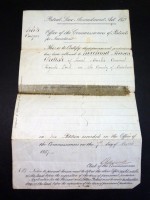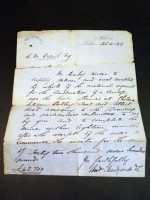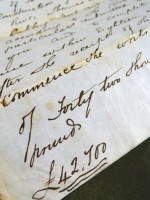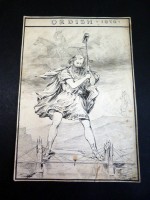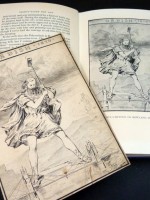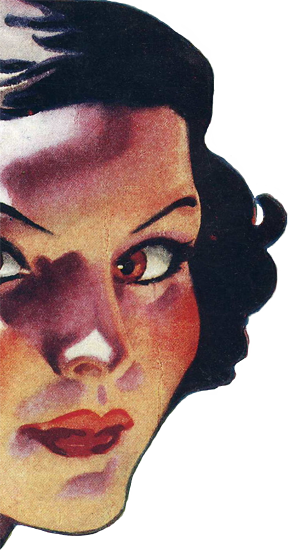Rowland Mason Ordish, original documents pertaining to Albert Bridge, 1857–1871
with an original drawing by Max Ende, and a signed copy of Harold Hartley's Eight Eight—Not Out (1939)
Author
Publisher
Printing Details
Here is a collection of original documents related to the engineer Rowland Mason Ordish, and others, and ephemera, some concerning his construction of London's Albert Bridge in 1873.
Rowland Mason Ordish (1824–1886) was a British engineer, his most notable constructions were the Winter Garden, Dublin (1865), his detailed work on the single-span roof of London's St Pancras railway station, (1868) and the Albert Bridge. His other work includes Holborn Viaduct, Franz Joseph I Suspension Bridge over the Vltava in Prague, the dome of the Royal Albert Hall, Cavenagh Bridge in Singapore, and the Esplanade Mansions in Mumbai, India.
He designed and built the Albert Bridge using his Ordish–Lefeuvre system for a modified cable-stayed bridge (it is the only remaining bridge in the world built to this system), but within 10 years it was considered unsafe so Sir Joseph Bazalgette incorporated some of the design elements of a suspension bridge. However, it remains a steadfast London landmark.
This collection contains:
1. An official certificate issued to Ordish from the Office of the Commissions of Patents for Inventions, dated 7th March 1857, "for the improvements in suspension bridges". Embossed with the government's crest and giving Ordish's address as Saint Mark's Crescent, Regents Park.
2. An 1868 letter from Lord Charles Wessely, handwritten and on crested paper. This is concerning the Franz Joseph suspension bridge crossing the Vlata in Prague. Wessely was the city engineer, and the letter requests a power of attorney being signed, and also mentions Max Ende (see the book and drawing below).
3. A handwritten letter from Andrew Handyside to Ordish, dated Feb 18, 1869, which reads "We hereby tender to supply, deliver and erect complete the whole of the material required for the construction of a bridge over the River Thames at Chelsea between Oakley Street and Albert Road according to the drawings and particulars submitted to us by you and to complete the same within eighteen months after the receipt of the order to commence the works for the sum of forty two thousand seven hundred pounds." Andrew Handyside and Co were iron founders from Derby, providing item from bridges to ornamental iron work (they produced one of the first standard Post Office boxes).
4. A handwritten letter from J Haywood (signed by his agent, A Gielgud) possibly to Ordish reducing a price quoted for a service by £350. This letter has Ordish's name printed to the head so may be part of his own services.
5. A handwritten letter from Hedworth Williamson to Ordish, dated 10th July 1871. Williamson was a speculator who acted as building contractor for the bridge. He had a slightly dubious history over share dealing but saw the potential. In 1871 he leased land by the bridge and undertook to build new villas (Rosenau and Anhalt Roads). This letter was sent a few months before his architect had drawn up the plans for housing, and makes financial arrangements with Ordish.
6. Ordish's daughter married into the Hartley family, and included is a signed copy of Harold Hartley's Eighty Eight—Not Out, published in 1939 by Frederick Muller (first edition, hardback). The author, Harold Thomas Hartley, (1851—1943) was a British journalist, publisher, mineral water manufacturer, and professional organiser of exhibitions (he staged the Venice in London at Olympia with Joseph Lyons). In the book he mentions his father in law, Rowland Ordish, and reproduces a drawing of Ordish by Max Ende. Ende was a German engineer and friend of Ordish, who designed bridges in America. This copy is signed by Hartley to Walter Shaw Sparrow, a writer on art and architecture and British sporting artists. There is also a letter from Hartley to Sparrow neatly pasted in to the book.
7. Finally, the original drawing of Rowland Mason Ordish by Max Ende is also included. It measures approximately 19 × 13cm, and is in black ink. It has been backed on card with some biro annotation to the reverse.
There are also some smaller items from the family of a later date—a photographic postcard of H T Hartley, handwritten notes on the above (modern) and newspaper clippings.
Condition
All the documents in nos 1–5 are original Victorian documents and as such, have some degree of wear, having been folded time after time, and the patent letter has a darkened strip where cellotape had been applied to the reverse. The book is in very good condition, and the original Max Ende drawing is also in very good order but with some tanning and light spotting. Overall, a very interesting collection on the history of London's bridge and its designer, Rowland Mason Ordish.
Further images are available on request.
Sold

